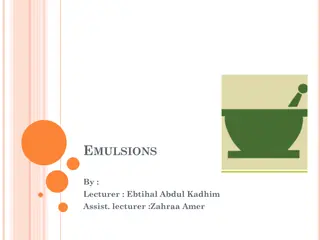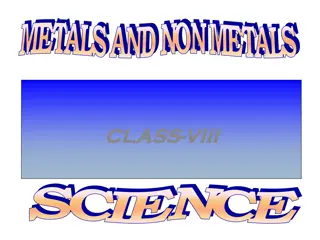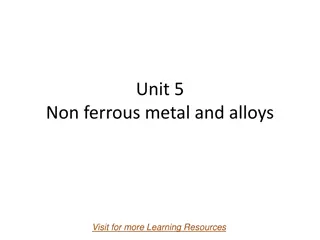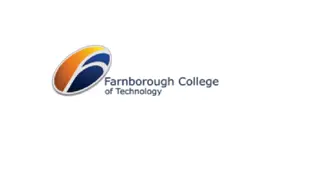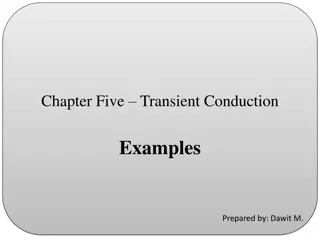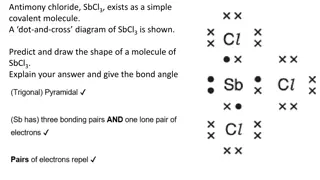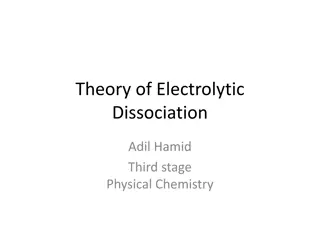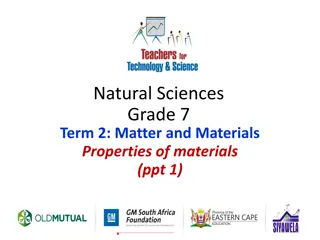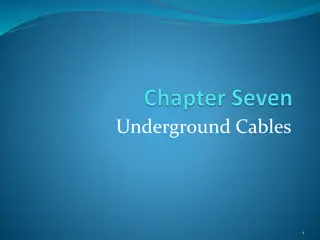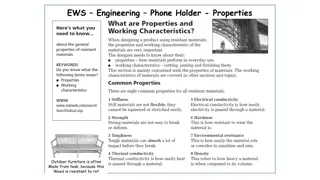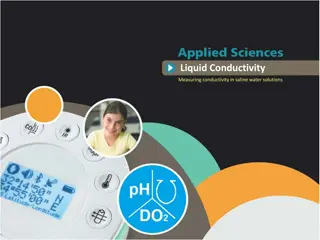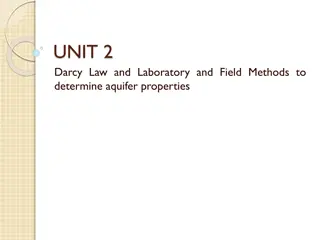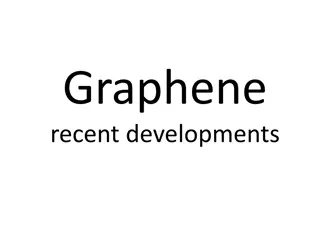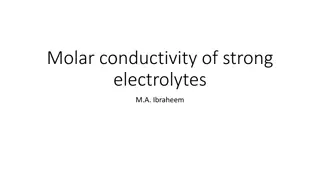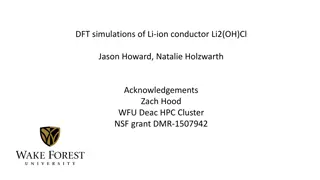Exploring the Fascinating World of Molecular Boranes and Their Applications
Molecular boranes, with a rich history dating back a century, have diverse applications ranging from rocket fuel to cancer therapy. This article delves into the identification of the first borane, advancements in metal borohydrides, and the synthesis of borane anions. The discussion extends to the c
0 views • 17 slides
Understanding Terrestrial Planets and Core Dynamics
Exploring the core-mantle interaction from the early Hadean period to present times reveals intriguing questions about the outer core's electrical conductivity, geodynamo sustainability, and inner core characteristics. Studies indicate challenges in maintaining the geodynamo, potential heat sources
9 views • 48 slides
Conductometry: An Overview of Measurement and Applications
Conductometry involves measuring the conductivity of a solution to determine its properties. This method includes factors affecting conductivity, conductometric titration, recent developments, and application examples. The process involves using electrodes, primary standard solutions, Wheatstone bri
9 views • 24 slides
Electromagnetic Surveying Methods and Applications
Electromagnetic surveying, conducted by Dr. Laurent Marescot, utilizes various methods like resistivity, induced polarization, and high-frequency techniques for exploration and investigation purposes. The electromagnetic method involves generating primary fields and detecting secondary fields to ana
2 views • 55 slides
Ring Type Lugs vs Screw Type Lugs
Cable lugs from Chetna Engineering Co. are also available in a ring shape. These insulated cable lugs are made up of the finest quality of copper that offers high conductivity & high purity. These lugs vary in type as insulated, non-insulated, and metal reinforcement.
8 views • 4 slides
Understanding Emulsions in Pharmaceuticals
Emulsions are dispersions where small liquid globules are distributed in an immiscible vehicle. While many pharmaceutical products are emulsions, some may fall into different categories. There are two main types of emulsions: oil dispersed in water (O/W) and water dispersed in oil (W/O). Factors aff
1 views • 33 slides
Understanding Metals: Properties, Reactions, and Applications
Metals exhibit unique properties such as conductivity, metallic bonding, and reactivity with acids. They can be combined to form alloys with enhanced characteristics. This overview covers the properties, reactions, and utility of metals in various applications, providing insights into their behavior
2 views • 50 slides
Understanding Metals, Non-Metals, and Their Properties in the Periodic Table
Classification of elements into metals, non-metals, and metalloids based on their properties is essential. Metals are known for their conductivity and malleability, while non-metals have contrasting features like brittleness and poor conductivity. This detailed overview explores the physical propert
0 views • 31 slides
Properties and Applications of Copper Alloys
Copper and copper alloys are essential materials due to their excellent properties like ductility, malleability, high conductivity, and corrosion resistance. Various types of copper alloys such as brasses are widely used in electrical conductors, utensils, coins, and industrial applications. Underst
0 views • 28 slides
Gas Chromatography Detectors: Flame Ionization and Thermal Conductivity
Gas chromatography detectors play a crucial role in separating and analyzing compounds in the pharmaceutical field. The Flame Ionization Detector (FID) utilizes hydrogen flame to ionize compounds eluted from the column, while the Thermal Conductivity Detector (TCD) principle involves converting elec
0 views • 13 slides
Understanding Heat Transfer: Conduction, Thermal Conductivity, and More
Explore the fundamentals of heat transfer through conduction and thermal conductivity as explained by Dr. J. Badshah. Learn about the modes of heat transfer, Fourier's law, thermal resistance, and the relationship between thermal and electrical conductivity. Discover the essential features of therma
1 views • 9 slides
Understanding Electron Theory and the Structure of Matter
The structure of matter is intricately tied to electron theory, where molecules are made up of atoms containing protons and electrons. An electrically neutral atom has an equal number of protons and electrons. A flow of electrons creates an electric current, which can be measured by an ammeter. Cond
0 views • 11 slides
Understanding Cardiac Electrical Activity in Physiology Team's Cardiovascular Block Lecture
Dive into the intricate details of cardiac electrical activity in this lecture led by Physiology Team 436. Explore topics like the cardiac conductive system, action potentials, refractory periods, excitation-contraction coupling, and the effects of autonomic stimulation on heart electrophysiology. D
0 views • 29 slides
Science Catch-Up Plan for Grades 7-9: April 2020
Explore a comprehensive catch-up plan for grades 7-9 in natural sciences compiled by Mr. Motsuenyane. The plan covers topics such as physical properties of materials, conducting experiments on strength, flexibility, boiling and melting points, conductivity, and environmental impacts. Grade 8 focuses
0 views • 9 slides
Overview of Semiconductor Materials and Applications
Understanding electronic transport in semiconductors is essential for various applications such as computers, smartphones, LEDs, and more. Semiconductors like silicon and compound semiconductors play a crucial role in creating devices with unique properties. By delving into the world of semiconducti
0 views • 20 slides
Transient Conduction in Thermal Energy Storage Units and Cylinders
Explore examples of transient conduction phenomena in thermal energy storage units, cylinders, and spheres. Learn how to calculate time durations, temperature changes, and energy removal rates during these heating and cooling processes. The examples cover scenarios involving aluminum slabs, oil bath
0 views • 10 slides
Chemical Bonding Concepts and Structures Explanation
Explore the concepts of chemical bonding through dot-and-cross diagrams for molecules like Antimony Chloride (SbCl3) and Boron Tribromide, along with explanations on ionic lattice structures, covalent bonds, and electrical conductivity in substances like Aluminium Fluoride (AlF3). Understand the sha
0 views • 9 slides
Theories of Electrolytic Dissociation and Ionization in Physical Chemistry
The theories of electrolytic dissociation by Adil Hamid and Arrhenius explain how electrolytes dissociate into ions in solution, leading to electrical conductivity. This process involves the migration of cations and anions towards opposite electrodes, affecting the conductivity of the electrolyte. T
1 views • 51 slides
Understanding Heat Conduction Through Hollow Spheres in Dairy Engineering
Dr. J. Badshah, a University Professor cum Chief Scientist at Sanjay Gandhi Institute of Dairy Technology, explains the conduction through hollow spheres with varying thermal conductivity. The concept of logarithmic mean area for hollow spheres and solving numericals related to conduction through a
1 views • 6 slides
Understanding Thermal Properties of Materials
Materials respond differently to heat based on their thermal properties such as heat capacity, thermal expansion, conductivity, and shock resistance. The ability of materials to absorb heat, expand with temperature changes, and conduct heat varies across ceramics, metals, and polymers. Heat capacity
0 views • 19 slides
Understanding Physical Properties of Materials in Grade 7 Natural Sciences
Exploring the physical properties of materials like strength and flexibility helps us decide which materials to use for specific purposes. Strong materials like steel and concrete are used in construction, while flexible materials like rubber and copper wire have different applications. Consideratio
1 views • 17 slides
Advantages and Requirements of Underground Cables
Underground cables offer advantages like better protection from damage, fewer faults, and improved appearance. However, they come with higher installation costs and insulation challenges at high voltages. Requirements include using high-conductivity stranded copper or aluminum conductors, proper ins
0 views • 22 slides
Exploring the Conductivity of Metals in Electrical Circuits
This science fair project investigates how different metals affect the amount of current in an electrical circuit. It explores why metals are used to conduct electricity, which metal is the best conductor, and includes a hypothesis based on research findings. The experimental design involves setting
0 views • 15 slides
Determination of Ester Hydrolysis Constant Rate by Conductivity Measurement
This study focuses on determining the ester hydrolysis constant rate through conductivity measurement, presenting a second-order reaction example. Conductivity meter is utilized for accurate monitoring. The procedure involves utilizing equal concentrations of ester and sodium hydroxide, measuring co
0 views • 6 slides
Understanding the Hall Effect in Conductors
The Hall Effect in conductors is described in detail, showcasing how a magnetic field affects the conductivity tensor, breaking symmetry and leading to unique properties. The discussion covers the separation of the conductivity tensor, the impact of magnetic fields on conductivity components, and th
1 views • 16 slides
Understanding Conductivity and Current in Extrinsic Semiconductors
This content delves into the intricacies of conductivity in extrinsic semiconductors, exploring the behavior of carriers in n-type and p-type materials. It covers topics such as drift current density, diffusion current density, the Einstein relation, recombination, and the Hall effect. Practical exa
0 views • 8 slides
Understanding Extrinsic Semiconductors: Fermi Level and Doping Effects
Extrinsic semiconductors play a crucial role in modern electronics by allowing controlled addition of impurities to tailor conductivity. The Fermi level in extrinsic semiconductors shifts based on the number of electrons and holes in the conduction and valence bands, influencing conductivity. Doping
0 views • 14 slides
Understanding Semiconductors: Intrinsic and Extrinsic Types
Semiconductors play a crucial role in electronic devices, with materials falling into three categories based on electric conductivity: Conductors, Insulators, and Semiconductors. Intrinsic semiconductors are chemically pure, while extrinsic semiconductors have impurities added to enhance their condu
0 views • 39 slides
Understanding Semiconductor Conductivity and Scattering Mechanisms
In the study of semiconductor conductivity, the concept of degenerate and non-degenerate semiconductors is discussed, showcasing the impact of doping levels. The conductivity equation is explored in terms of electron and hole mobilities and densities. The role of scattering mechanisms, such as latti
0 views • 18 slides
Understanding Groundwater Flow in Aquifers
Groundwater flow in aquifers, whether confined or leaky, involves complex concepts like aquifer transmissivity, storativity, conductivity, Darcy's law, and continuity equations. Focusing on horizontal flow approximation and utilizing formulas for transmissivity and conductivity allows us to study th
0 views • 15 slides
Understanding Material Properties for Outdoor Furniture
Outdoor furniture made from teak is popular due to its resistance to rot. Exploring the properties like ability to withstand breaking and deforming, thermal conductivity, electrical conductivity, durability, and more helps in choosing the right materials for various applications. The article also di
0 views • 7 slides
Understanding Conductivity in Saline Water Solutions
Study the relationship between dissolved ions and conductivity in saline water solutions to determine molar conductivity. Learn about conductive solutions, advantages/disadvantages, and factors influencing conductivity. Engage in hands-on experiments using SensorLab conductivity sensors to investiga
0 views • 22 slides
Understanding Darcy Law and Methods for Aquifer Property Evaluation
Darcy Law, introduced by Henry Darcy, defines the relationship between flow rate, head loss, cross-sectional area, and flow path length in porous media like aquifers. By conducting experiments and measuring hydraulic conductivity, Darcy Law allows estimation of groundwater velocity and flow characte
0 views • 49 slides
Types of Conductors in Transmission Lines
Aluminum conductors, such as AAC, AAAC, ACSR, and ACAR, are commonly used in transmission lines due to their high conductivity, tensile strength, light weight, and resistance to corrosion. AAC is known for its good conductivity but limited strength, while AAAC offers better mechanical strength and c
0 views • 17 slides
Exploring the Fascinating World of Graphene: Recent Developments and Future Applications
Graphene, a single thin layer of graphite, has revolutionized the field of materials science since its discovery in 2004. This remarkable material, composed of tightly packed carbon atoms in a hexagonal pattern, possesses exceptional properties, including high electrical conductivity, mechanical str
0 views • 21 slides
Energy Level Formation in Semiconductor Materials
Energy levels in isolated atomic structures form discrete levels which expand to bands in insulators, semiconductors, and conductors. Extrinsic materials like n-type and p-type are created by doping semiconductors with impurity atoms to alter conductivity. The n-type material involves adding pentava
0 views • 4 slides
Understanding Molar Conductivity of Strong Electrolytes
Strong electrolytes are materials highly dissociated in water, leading to conducting solutions with high molar conductivity. This article delves into the concept, calculation methods, and experimental procedures for determining the molar conductivity of strong electrolytes using examples of NaCl, KC
0 views • 5 slides
Understanding Conductivity in Saline Water Solutions
Explore the relationship between dissolved ions and conductivity in saline water solutions through experiments using Labdisc conductivity sensors. Learn about molar conductivity, advantages, and disadvantages of conductive solutions, and the factors influencing solution conductivity. Students will m
0 views • 22 slides
Effects of Thermal Conductivity on Flame Spread over Carbon-fiber Composites
The research focuses on the impact of thermal conductivity on flame spread over carbon-fiber composites used in commercial airplanes. The study delves into pyrolysis kinetics, heat release rates, and ignition behavior to enhance in-flight safety by understanding downward flame spread. Experimental d
0 views • 12 slides
Understanding Lithium Ion Conduction in Li2(OH)Cl Through DFT Simulations
DFT simulations were conducted on the lithium ion conductor Li2(OH)Cl to investigate its low and high-temperature phases. The motivation behind the study was to uncover the structural features impacting the phase transition and diffusion properties of the material. The background highlighted two pha
0 views • 16 slides





